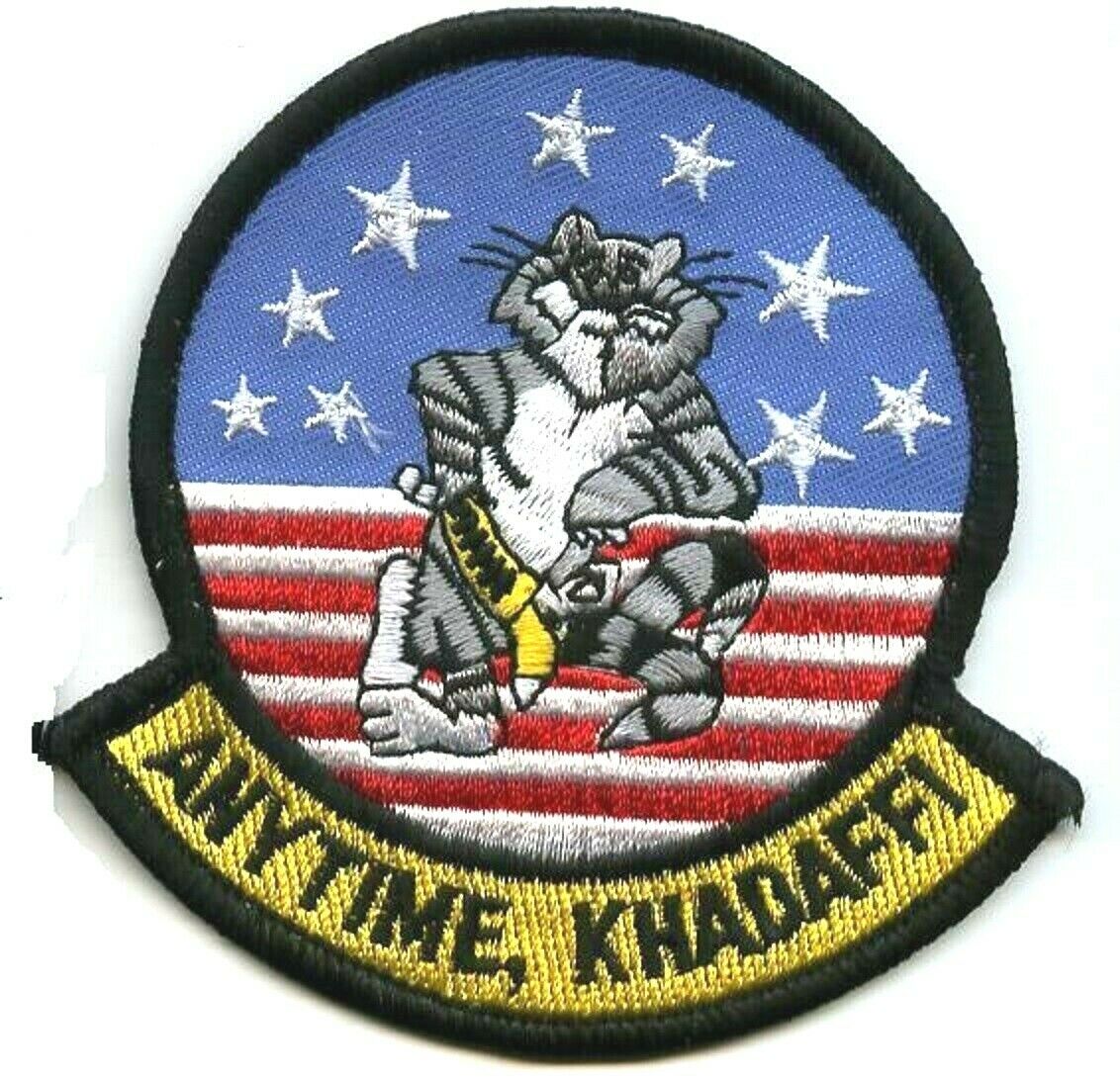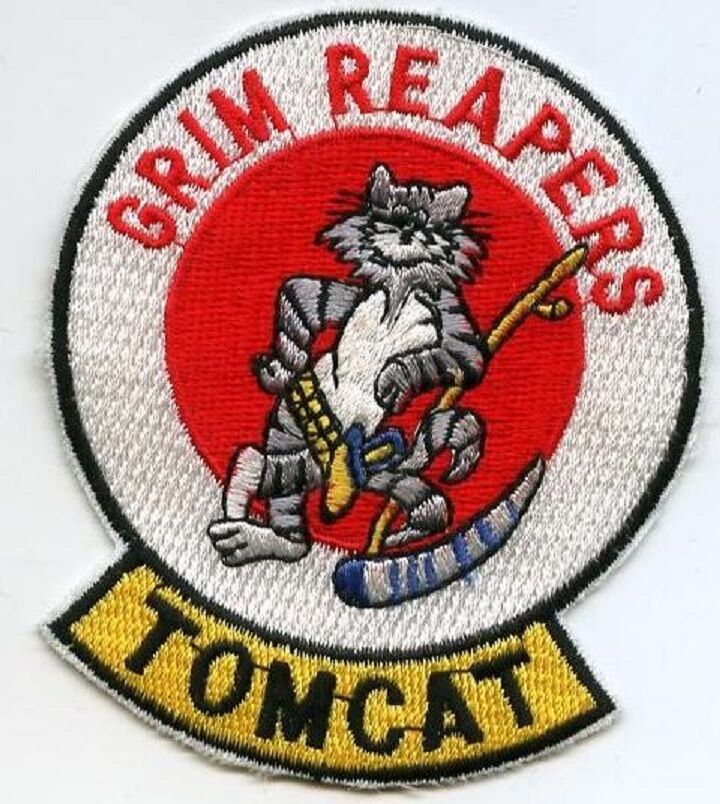-40%
1986 US RAID on LIBYA TOMCAT F-14 TOP GUN FIGHTER INSIGNIA: Anytime Gaddafi
$ 10.55
- Description
- Size Guide
Description
1986 US RAID on LIBYA TOMCAT F-14 TOP GUN FIGHTER INSIGNIA: Anytime GaddafiThis is a very special USN F14 TOMCAT TOP GUN FIGHTER Sqn
1986 US RAID on LIBYA TOMCAT F-14 TOP GUN FIGHTER INSIGNIA: Anytime Gaddafi. Please note that there are color variations due to different settings on different PCs and different Monitors. The color shown on your screen is most likely not the true color
. You will receive the item as shown in the first photo
.
The 1986 United States bombing of Libya, code-named Operation El Dorado Canyon, comprised air strikes by the United States against Libya on Tuesday, 15 April 1986. The attack was carried out by the U.S. Air Force, U.S. Navy and U.S. Marine Corps via air strikes, in retaliation for the 1986 Berlin discotheque bombing. There were 40 reported Libyan casualties, and one U.S. plane was shot down. One of the Libyan dead was a baby girl, who was reported to be Gaddafi's daughter, Hanna Gaddafi. However, there were doubts as to whether she was really killed, or whether she really even existed. After years of occasional skirmishes with Libya over Libyan territorial claims to the Gulf of Sidra, the United States contemplated a military attack to strike targets within the Libyan mainland. In March 1986, the United States, asserting the 12-nautical-mile (22 km; 14 mi) limit to territorial waters according to international law, sent a carrier task force to the region. Libya responded with aggressive counter-maneuvers on 24 March that led to the Gulf of Sidra incident. The attack began at 0200 hours (Libyan time), and lasted about twelve minutes, with 60 tons of munitions dropped. Eighteen F-111 bombers supported by four EF-111 electronic countermeasures aircraft flying from the United Kingdom bombed Tripoli airfield, a frogman training center at a naval academy, and the Bab al-Azizia barracks in Tripoli. During the bombing of the Bab al-Azizia barracks, an American F-111 was shot down by a Libyan surface-to-air missile (SAM) over the Gulf of Sidra. Some bombs landed off-target, striking diplomatic and civilian sites in Tripoli, and narrowly missing the French embassy. Some Libyan soldiers abandoned their positions in fright and confusion, and officers were slow to give orders. Libyan anti-aircraft fire did not begin until after the planes had passed over their targets. Twenty-four A-6 Intruders and F/A-18 Hornets launched from aircraft carriers bombed radar and antiaircraft sites in Benghazi before bombing the Benina and Jamahiriya barracks.
Muammar Mohammed Abu Minyar Gaddafi[b] (/ˈmoʊəmɑːr ɡəˈdɑːfi/; c. 1942 – 20 October 2011), commonly known as Colonel Gaddafi, was a Libyan revolutionary, politician, and political theorist. He governed Libya as Revolutionary Chairman of the Libyan Arab Republic from 1969 to 1977, and then as the "Brotherly Leader" of the Great Socialist People's Libyan Arab Jamahiriya from 1977 to 2011. He was initially ideologically committed to Arab nationalism and Arab socialism but later ruled according to his own Third International Theory. Born near Sirte, Italian Libya to a poor Bedouin family, Gaddafi became an Arab nationalist while at school in Sabha, later enrolling in the Royal Military Academy, Benghazi. Within the military, he founded a revolutionary group which deposed the Western-backed Senussi monarchy of Idris in a 1969 coup. Having taken power, Gaddafi converted Libya into a republic governed by his Revolutionary Command Council. Ruling by decree, he ejected Libya's Italian and Jewish minorities and closed its Western military bases. Strengthening ties to Arab nationalist governments—particularly Gamal Abdel Nasser's Egypt—he unsuccessfully advocated Pan-Arab political union. An Islamic modernist, he introduced sharia as the basis for the legal system and promoted "Islamic socialism". He nationalized the oil industry and used the increasing state revenues to bolster the military, fund foreign revolutionaries, and implement social programs emphasizing house-building, healthcare and education projects. In 1973, he initiated a "Popular Revolution" with the formation of Basic People's Congresses, presented as a system of direct democracy, but retained personal control over major decisions. He outlined his Third International Theory that year, publishing these ideas in The Green Book. Gaddafi transformed Libya into a new socialist state called a Jamahiriya ("state of the masses") in 1977. He officially adopted a symbolic role in governance but remained head of both the military and the Revolutionary Committees responsible for policing and suppressing dissent. During the 1970s and 1980s, Libya's unsuccessful border conflicts with Egypt and Chad, support for foreign militants, and alleged responsibility for the Lockerbie bombing in Scotland left it increasingly isolated on the world stage. A particularly hostile relationship developed with the United States, United Kingdom, and Israel, resulting in the 1986 U.S. bombing of Libya and United Nations-imposed economic sanctions. From 1999, Gaddafi shunned Arab socialism and encouraged economic privatization, rapprochement with Western nations, and Pan-Africanism; he was Chairperson of the African Union from 2009 to 2010. Amid the 2011 Arab Spring, protests against widespread corruption and unemployment broke out in eastern Libya. The situation descended into civil war, in which NATO intervened militarily on the side of the anti-Gaddafist National Transitional Council (NTC). The government was overthrown, and Gaddafi retreated to Sirte, only to be captured and killed by NTC militants. A highly divisive figure, Gaddafi dominated Libya's politics for four decades and was the subject of a pervasive cult of personality. He was decorated with various awards and praised for his anti-imperialist stance, support for Arab—and then African—unity, and for significant improvements that his government brought to the Libyan people's quality of life. Conversely, Islamic fundamentalists strongly opposed his social and economic reforms, and he was posthumously accused of sexual abuse. He was condemned by many as a dictator whose authoritarian administration violated human rights and financed global terrorism..The 1986 United States bombing of Libya, code-named Operation El Dorado Canyon, comprised air strikes by the United States against Libya on Tuesday 15 April 1986. The attack was carried out by the U.S. Air Force, U.S. Navy and U.S. Marine Corpsvia air strikes, in retaliation for the 1986 West Berlin discotheque bombing. There were 40 reported Libyan casualties, and one U.S. plane was shot down. One of the claimed Libyan deaths was of a baby girl, reported to be Muammar Gaddafi's daughter, Hana Gaddafi.[3] However, there were doubts as to whether she was really killed, or whether she really even existed. The attack began at 0200 hours (Libyan time), and lasted about twelve minutes, with 60 tons of munitions dropped. Eighteen F-111 bombers supported by four EF-111 electronic countermeasures aircraft flying from the United Kingdom bombed Tripoli airfield, a frogman training center at a naval academy, and the Bab al-Azizia barracks in Tripoli. During the bombing of the Bab al-Azizia barracks, an American F-111 was shot down by a Libyan ZSU-23-4 over the Gulf of Sidra. Some bombs landed off-target, striking diplomatic and civilian sites in Tripoli, and narrowly missing the French embassy. Some Libyan soldiers abandoned their positions in fright and confusion, and officers were slow to give orders. Libyan anti-aircraft fire did not begin until after the planes had passed over their targets. Twenty-four aircraft of Carrier Wing 13, CVW-13, A-6 Intruders and F/A-18 Hornets, armed with anti-radar HARM missiles in their first combat use, launched from aircraft carriers USS Coral Sea and USS America bombed radar and antiaircraft sites in Benghazi before bombing the Benina and Jamahiriya barracks.
Other items in other pictures are for your reference only, available in my eBay Store. They will make a great addition to your SSI Shoulder Sleeve Insignia collection. You find only US Made items here, with the same
LIFE-TIME
warranty.
**
eBay REQUIRES ORDER BE SENT WITH
TRACKING
, PLEASE SELECT
USPS 1ST CLASS SERVICE w/TRACKING
**
**
eBay REQUIRES ORDER BE SENT WITH
TRACKING
, PLEASE SELECT
USPS 1ST CLASS SERVICE w/TRACKING
**
We'll cover your purchase price plus shipping.
FREE 30-day No-Question return
ALL US-MADE PATCHES HAVE LIFETIME WARRANTY
We do not compete price with cheap import copies.
Watch out for cheap import copies with cut-throat price;
We beat cheap copies with Original design, US-Made Quality and customer services.
Once a customer, a LIFETIME of services


















